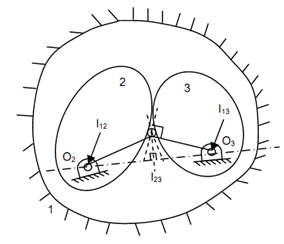Kennedy's Theorem:
This theorem is also known as 'Three Centres in Line Theorem' or 'Aronhold-Kennedy Theorem of Three Centres.' This theorem said:
'If three bodies are in relative motion w . r. t. one another, the three instantaneous centres of velocity are collinear.'
Proof
Given fig shows three links 1, 2 and 3 in relative motion w. r. t. one another. Link 1 is fixed while links 2 & 3 contain motion. The instantaneous centres I12 & I13 are at hinges O2 and O3 respectively. Regarding these points, links 2 & 3 rotate. The third instantaneous centre I23 also lies in the plane of motion. If I23 does not lie on the line joining I12 & I13, it can lie above or below this line.
Consider its position above the line joining I12 & I13 as illustrated in the figure. Instantaneous centre I23 may be considered with link 2 & link 3. Referring I23 as a point along link 2, its velocity ought to be perpendicular to line joining I12 & I23. If I23 be referred along link 3, its velocity ought to be perpendicular to the line joining I13 and I23 these two directions are different. However by definition I23 ought to have similar velocity whether it is referred to be with link 2 or 3 and in this case this is not so. It means I23 may not lie above the line joining I12 & I13. Alike case shall occur if point I23 is considered below the line I12, I23. Thus, I23 may lie on the line I12 I13 just or else the directions of velocity shall be different while it is considered with link 2 & 3. it proves that the three instantaneous centres I12, I13 and I23 are collinear.

Kennedy's Theorem